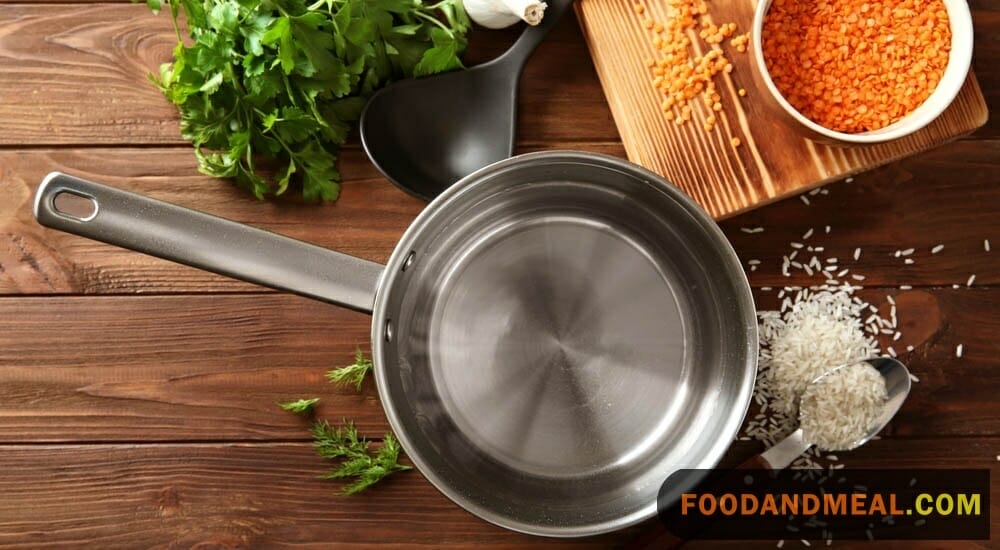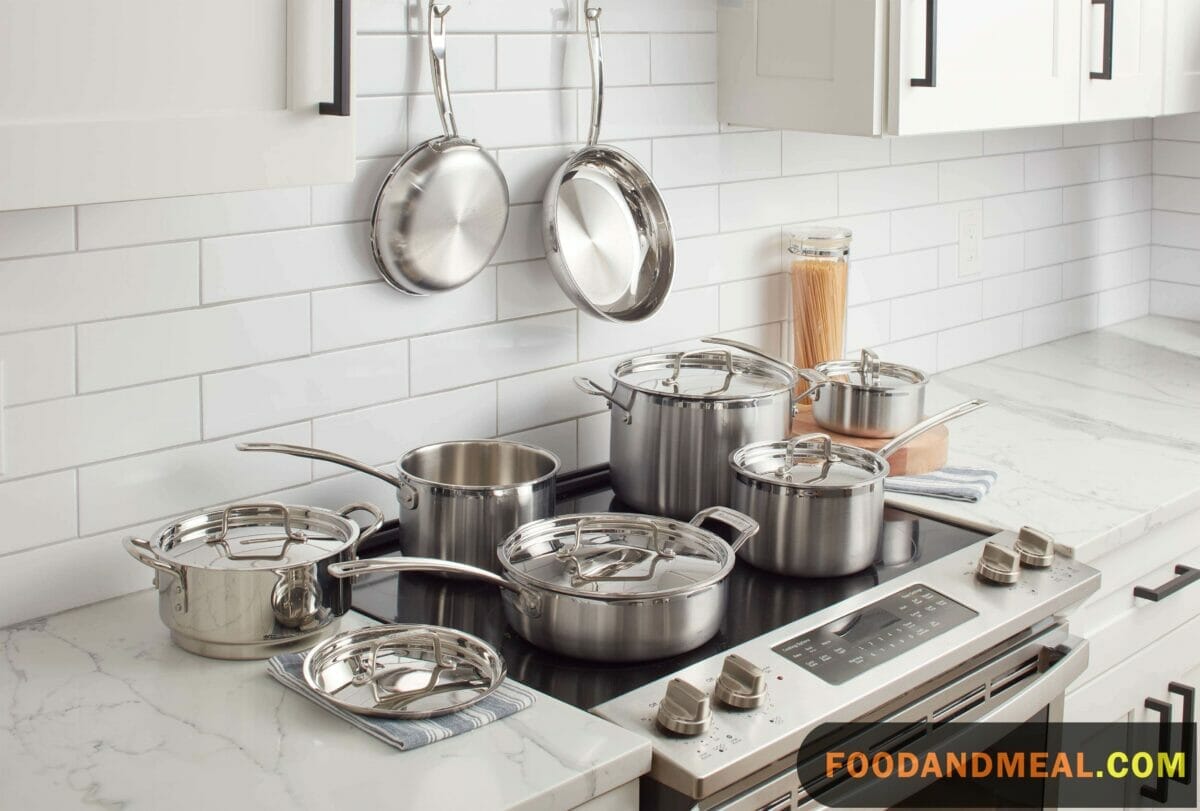Cooking with stainless steel is highly valued for its versatility and lighter weight compared to cast iron. Discover the benefits, seasoning, cooking techniques, and care tips in our stainless steel guide, offering valuable insights for both chefs and home cooks with Food and Meal.
Benefits of Stainless Steel Cookware
When faced with a range of cookware options like ceramic, aluminum, or non-stick, what sets stainless steel apart? While the choice ultimately depends on personal preference, stainless steel cookware boasts a multitude of advantages, positioning it as a favored option for professional chefs. One significant factor in this preference is stainless steel’s durability, especially in demanding culinary environments. Unlike non-stick cookware, which struggles with the rigors of professional kitchens—often subjected to high heat and metal utensils—stainless steel shines.

Additional merits of stainless steel encompass:
- Lighter weight compared to cast iron.
- Non-reactive nature.
- Oven-safe properties.
- Ideal for browning and searing.
Is Stainless Steel Effective for Cooking?
Stainless steel cookware may not be as non-stick as other pans, increasing the likelihood of food sticking. However, the results it produces are often superior. Professional chefs laud stainless steel for its ability to create delectably caramelized dishes, whether it’s onions or chicken breasts. Its durability, high-heat resistance, and impressive heat retention contribute to its widespread popularity.
Is Stainless Steel Always Uncoated?
Not all stainless steel is uncoated; some varieties come with non-stick coatings. Nevertheless, uncoated stainless steel remains a preferred choice across kitchens. As the name suggests, uncoated stainless steel lacks any external coating, making it a versatile and reliable option.
Tips for Cooking with Stainless Steel Pots and Pans

When it comes to cooking with stainless steel, specific methods and techniques are key. Employing proper cooking techniques not only preserves the lifespan of your stainless steel cookware but also maximizes the potential of your pots and pans. Whether you’re using a stainless steel saucepan, frying pan, or wok, the following cooking advice is invaluable:
| Preheating is Crucial | Place your empty stainless steel pan on a medium heat burner for 2 to 3 minutes before cooking. Cold stainless steel’s porous nature can lead to food sticking. Preheating minimizes this effect by reducing the pan’s porosity. |
| Oil After Preheating | Add oil to the preheated pan. Doing so after preheating prevents the oil from settling into the pan’s pores, enhancing its effectiveness in preventing food from sticking. Take the pan off the heat, add oil, and swirl it to lightly coat the surface—oil heats rapidly. |
| Use Room Temperature Foods | Allow your ingredients to reach room temperature before adding them to the pan. Introducing cold food lowers the pan’s temperature, promoting food sticking. Let food sit out of the fridge before cooking. |
| Test the Pan’s Heat | Prior to adding oil, gauge the pan’s temperature by dropping a small amount of food or a water droplet into it. The ‘TSS’ sizzling sound indicates readiness. |
| Practice Patience | When searing meat, be patient. The pan signals readiness by preventing sticking once the meat forms a crust. Flipping becomes effortless as the pan releases the meat when perfectly seared. Avoid forcefully lifting meat if it seems stuck; it requires more cooking time. |
| Utilize Stuck-On Bits | Stainless steel’s tendency to retain bits of food can be an asset. These remnants contribute to rich sauces and gravies, imparting flavor and complexity. These morsels serve as a foundation for your culinary creations. |
How to Care for Stainless Steel Pans
Maintaining stainless steel cookware for the long haul requires proper care. Here are essential tips to ensure your stainless steel cookware remains in great condition for years to come.
- Allow Cooling Time: Let your cookware cool down before cleaning. This rule applies universally to all cookware types. While it cools, gently wipe away any leftover oil or food using a paper towel, if safe to do so.
- Check Dishwasher Compatibility: While many cookware items are dishwasher safe, it’s wise to confirm. If you’re uncertain, handwashing might be preferable. Extended cycles of high temperatures in dishwashers can potentially harm your pots and pans.
- Keep It Dry: Prevent rusting by thoroughly drying your stainless steel after washing. Store it in a moisture-free, shaded spot. Ensuring your cookware remains pristine is vital for its enduring performance.
Preserve the impeccable appearance and functionality of your cookware by following these stainless steel care instructions. For comprehensive care information tailored to different cookware materials, consult our general cookware care guide. This resource will further safeguard the quality and longevity of your cookware.
Stainless Steel Care Mistakes to Avoid
To maintain the pristine condition of your stainless steel cookware indefinitely, sidestep the following errors that can compromise their quality:
Mistake #1: Relying on the Dishwasher
While stainless steel cookware often bears a dishwasher-safe label, it’s wise not to fully depend on this method. Extended cycles and high temperatures can harm the surface and handles of your cookware.
Mistake #2: Cleaning Before Cooling
Subjecting hot cookware to cold water invites warping and cracking, and the temperature disparity creates steam that might scald your hands. Exercise patience; allow the cookware to cool before cleaning.
Mistake #3: Adding Salt to Cold Water
Seasoning pasta water is common, but timing is key. Add salt after the water reaches a boil to avoid pitting the pan’s surface irreversibly.

Mistake #4: Neglecting Calcium Build-Up
Mineral deposits can accumulate over time. Remove them by boiling a mixture of 3/4 cup water and 1/4 cup vinegar in the pan. After cooling, wash and dry the pan.
Mistake #5: Overheating
Rainbow stains that resist scrubbing could be signs of overheating. Address this by gently scrubbing with vinegar or cooking acidic foods like tomato sauce, which helps alleviate discoloration.
Mistake #6: Skipping Drying
Hand-drying your pans prevents the development of water spots on stainless steel. Despite its brief nature, this task significantly enhances their appearance.
Mistake #7: Allowing Burnt Bits
Preheat pans before cooking to prevent food sticking and burnt bits. If burnt residue forms, boil water in the pan to loosen it without resorting to abrasive methods.
Mistake #8: Using Steel Wool
Avoid steel wool, as it scratches and damages stainless steel finishes. Opt for nonabrasive sponges to maintain your cookware’s integrity.
By steering clear of these missteps, you can enjoy the longevity and performance of your stainless steel cookware for years to come.

19 February ·
Stainless Savvy: Mastering the Art of Stainless Steel Cooking
By Food And Meal
Welcome back to another episode of "Kitchen Chronicles," where we explore the wonders of cooking. I'm Jenny, and today we're delving into the benefits of using stainless steel cookware. In a world filled with various options, stainless steel stands out for good reasons. So, let's dive in and uncover the secrets of this kitchen essential!
I'm Kelly Atkinson, with a passion for dissecting the world of home goods. My reviews stem from thorough testing and a love for sharing detailed insights. Each piece I write offers a glimpse into my explorative journey, aiming to guide readers to informed choices with authenticity and precision, making every review a blend of exploration and expertise.
